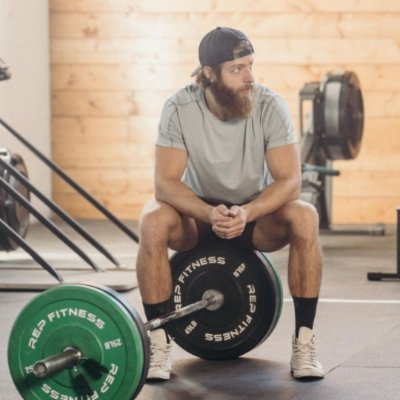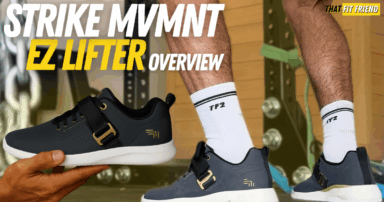If you’re to CrossFit, then you’ve likely wondered, “Do my shoes matter for my CrossFit workouts?” Can you just wear your normal shoes? Will running shoes work? These are all really valid questions and in this article, I’m going to break down and discuss why your shoes matter for CrossFit workouts.
The best way to think about CrossFit shoes and CrossFit workouts is to compare them to using a pair of soccer cleats for a game of soccer. A CrossFit shoe will set you up for success in CrossFit workouts as they’re specific for this style of training much like a soccer cleat is specific for helping you to excel in soccer.
Essentially, I like to teach athletes and lifters to conceptualize their shoes in CrossFit similar to using tools to get a job done.
We need to use the right tools for the job to ensure we’re both efficient and getting the most out of our performance. For another example, this is why it’s sub-optimal to lift heavy weights in running shoes.
Table of Contents+
On the market for new cross-training shoes? Try out the Training Shoe Finder to be matched with your perfect pairs of training shoes!
Do Shoes Matter In CrossFit?
Yes, shoes matter in CrossFit and they can be a serious help for allowing you to perform your best. If you’re tackling CrossFit workouts, then you’re going to want a really good pair of cross-training shoes.
The right pair of shoes for CrossFit will provide you with more stability, durability, and versatility for tackling the diverse range of tasks that come with CrossFit workouts.
1. Increased Stability When Lifting
The first reason why shoes matter in CrossFit is due to the fact that a great for cross-training shoes and CrossFit shoes will provide you with more stability when lifting. Shoes, and more specifically cross-training shoes that are designed for CrossFit, will be constructed with midsoles and outsoles that are designed to limit compression under different loads.
Most CrossFit shoes will feature midsoles that are constructed with either medium or high-density foam. This material will provide you with a blend of stability and versatility so if you’re training heavy you won’t have to worry about losing balance or stability to your shoe compressing under your foot. It will also provide you with a consistent feeling when lifting weights.
For a practical example, imagine wearing a really thick pair of running shoes and doing a squat or a clean in them. Then, think about accidentally shifting forward during this exercise. What’s likely going to happen? The toe will likely compress under the load and your shift of balance which could then cause your performance to tank due to a lack of stability and balance.
In addition to featuring midsoles designed for limiting compressing, a good pair of shoes for CrossFit will also usually feature fully rubber outsoles. This style of outsole construction will provide an additional layer of stability and grip when training heavy and lifting during CrossFit workouts.
2. Better Upper Construction Durability
Another reason why your shoe selection matters for CrossFit is due to the upper durability that you’ll get from a good pair of CrossFit shoes. When we think about CrossFit workouts and the wide range of exercises that we can perform during them, then it’s pretty easy to see how these workouts can be pretty tough on your shoes.
For example, think rope climbs, burpees, handstand push-ups, and box jump overs. All of these exercises and movements can leave the upper construction in your shoes to take a pretty massive beating.
The additional friction and abrasion that come from these exercises can cause uppers to thin, rip, and break down faster than more traditional training. A great CrossFit shoe will utilize materials throughout its upper construction to prolong its overall lifespan.
By using thicker upper materials and layering materials accordingly in high frictions areas like the toe box and mid-foot, your shoes will be better poised to last longer than non-CrossFit shoes.
Basically, a shoe optimized for CrossFit will account for areas on your shoes that will typically break down fast during CrossFit workouts. Your wallet will thank you for using the right type of shoes for CrossFit.
3. Designed for Versatility
To follow-up the point on increased stability above, great CrossFit shoes will also be your best bet for being versatile and tackling a wide range of activities. Shoes designed for training and sport always land on spectrums of specificity. For example, running shoes will always fair better for running compared to a pair of training shoes because the running shoes are designed for that activity.
When we talk about CrossFit and the range of activities that you can perform in one workout, then you’ll want a shoe that is optimized to be an okay model for things like lifting, shorter runs, plyometrics, HIIT-style training, and more. A CrossFit shoe will land in the middle in a variety of spectrums for specificity and this is why they’re so great for versatility.
They can basically hold their own in whatever type of training that will exist in a CrossFit that you throw at them and their dropoff will come much later than a specialized shoe that isn’t very versatile.
For example, if you tried to use a running shoe for CrossFit, then you’d likely run into stability issues when lifting, upper durability issues when climbing ropes, and your performance could suffer when tackling plyometrics. They lack the range to excel for a bunch of different things due to their more pigeon-holed construction.
Why Are CrossFit Shoes Different?
CrossFit shoes are different from traditional training shoes and running shoes for a variety of reasons. When we think about cross-training shoes that are optimized for CrossFit the devil’s in the details when it comes to their differentiating factors.
We alluded to some of the differences above in our why “why CrossFit shoes matter section”, but let’s go ahead and dive deeper into some of the construction details that make CrossFit shoes different from their peers.
CrossFit Shoes Vs Running Shoes
When looking at differences between CrossFit and running shoes, the main differences are in the durability and stability that each shoe will provide. CrossFit shoes will be much more stable than running shoes and this is why running long distances in CrossFit shoes is often very uncomfortable.
Additionally, the upper constructions used in running shoes are typically optimized to save as much weight as possible. Lightweight upper constructions can be prone to lacking abrasion resistance which is different from the thicker layered materials that you’ll get in most CrossFit shoes.
Remember, we want to use the right tools for the job. In the case of CrossFit shoes versus running shoes, both shoes are for training but they should be used for their intended purposes to get the most out of the shoes you’re wearing.
In summary, CrossFit shoes are different because they have construction designed specifically for CrossFit workouts.
- Purposely Made Durable Upper Constructions
- Stable Midsoles and Outsoles
- Features to Promote Performance In Niche Exercises (ex: rope climbs, handstand push-ups)
- Fully Rubber Outsoles for Traction
- Lower Stack Heights and Heel-to-Toe Drops for Balance/Stability
If you’re on the market for new CrossFit shoes, then I’d also suggest checking out my trainer sizing guide. This video will answer a lot of common questions that I receive for this style of footwear!
How Long Do CrossFit Shoes Last?
CrossFit shoes will vary in regard to how long they last. The type of CrossFit shoe you’re using along with your workout frequency, duration, and intensity can all create a variance in regard to how long the average CrossFit shoe will last.
In general, the average CrossFit shoe should last you anywhere from 8-months to a year. If you get lucky and get a really good pair or use them only a couple of times a week, then they can last you 12+ months.
Some CrossFit shoes will come with construction features like mid-foot guards for rope climbs that can help to prolong their lifespan a little bit. For example, the Nike Metcon 6 and Nike Metcon 7 are good examples of utilizing thicker midfoot materials.
It’s important to note, though, that the ranges above are simply averages that I’ve noticed throughout my time reviewing and discussing cross-training shoes with other CrossFit athletes. There is no one-size-fits-all “your CrossFit shoes will last exactly this amount of time” equation.
You can gain an idea and have a guess when looking at certain shoe’s construction features, but again, this can all vary per the shoe, your training style, and much more.
Frequently Asked Questions (FAQ)
Q:Do shoes matter in CrossFit?
Q:How long do CrossFit shoes last?
Q:Why are CrossFit shoes different?
Takeaway Thoughts
When tackling CrossFit workouts, your shoe choice matters. CrossFit workouts are diverse, but also specific which means it’s a great idea to get a pair of shoes that are designed for tackling this style of training.
The right pair of CrossFit shoes will last longer and will allow you to perform your hardest in a wider range of activities without your performance being compromised due to poor shoe selection.
If you have any questions about cross-training shoes and CrossFit shoes, drop a comment below or reach out to me personally via Instagram (@jake_boly).















Add a Comment